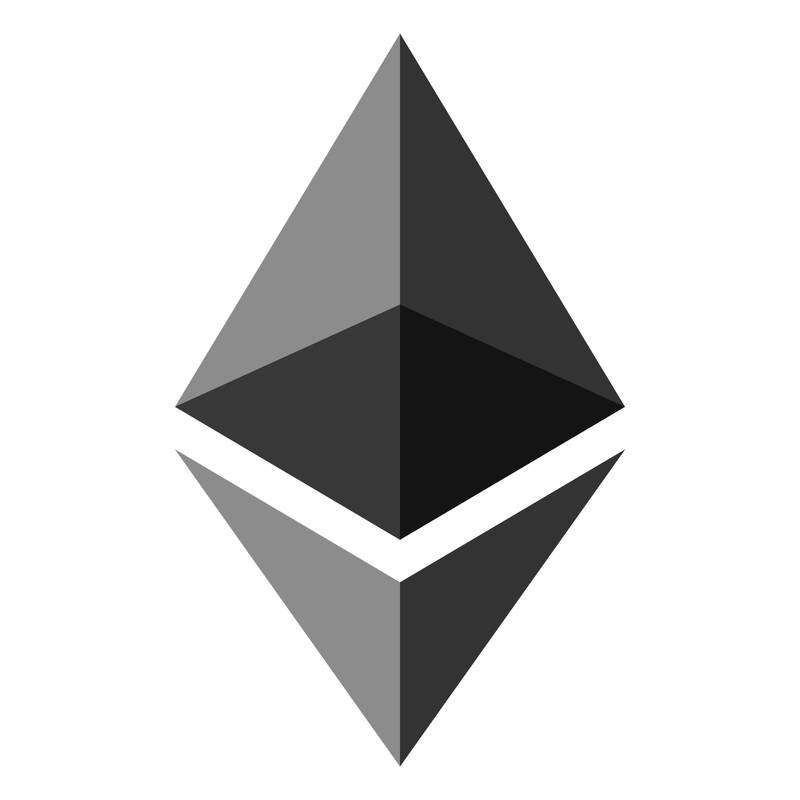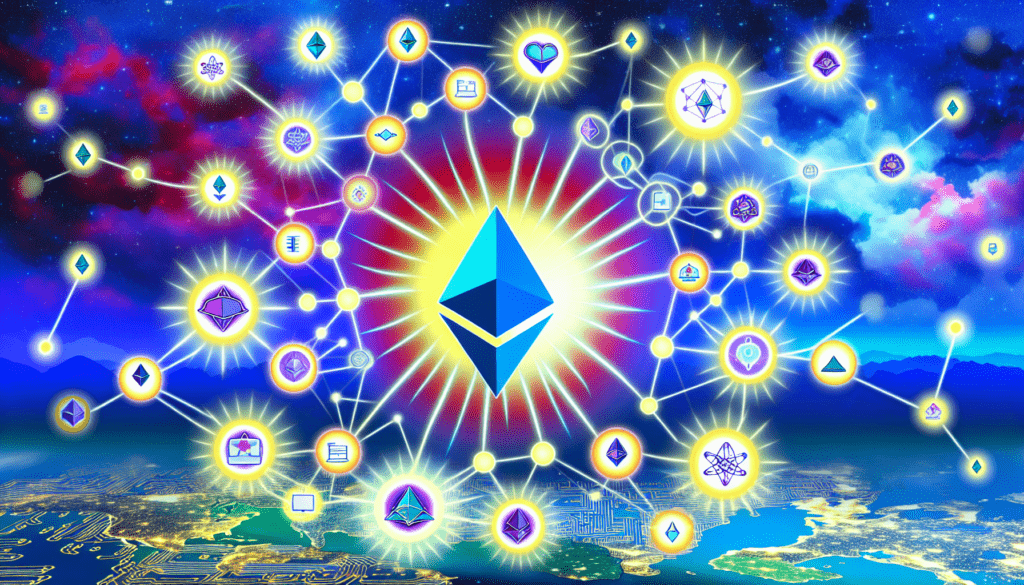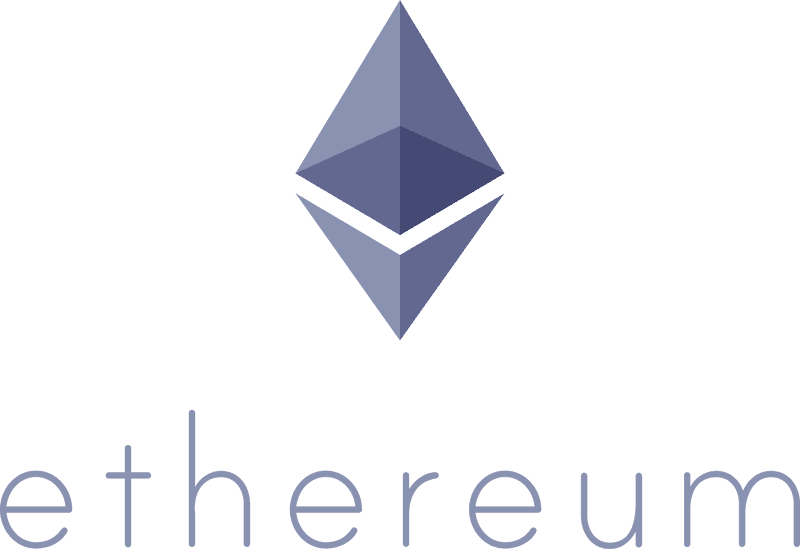Latest News
- ETH Price Analysis: Ethereum Drop to $1100 Not Impossible
- Solana Overtakes Ethereum in Staking, Hits $12.73B Stablecoin Cap and $135 Price
- What Crypto Whales are Buying For May 2025
- Vitalik Buterin floats swapping Ethereum’s EVM for RISC-V to boost scalability
Current Price
The current price of ETH is $1,580.44828
Introduction
When you think about Ethereum, you’re looking at more than just another cryptocurrency; it’s a robust platform for creating and executing smart contracts and decentralized applications.
Launched in 2015, Ethereum has considerably shaped the digital economy by enabling transactions without intermediaries.
Now, with the Ethereum 2.0 upgrade delivered securely, focusing on scalability and efficiency, the blockchain world is bracing for some major shifts.
Curious about how Ethereum stacks up against Bitcoin, or what smart contracts really mean for the future?
Let’s explore these facets further in this review.

Quick Overview
- Smart Contracts: Ethereum enables self-executing smart contracts, automating transactions and ensuring transparency without intermediaries.
- Ethereum 2.0 Upgrade: Transition to Proof of Stake and sharding improves scalability, transaction speed, and energy efficiency.
- Decentralized Applications (dApps): Ethereum supports diverse dApps across sectors like finance and gaming, democratizing access to digital services.
- Comparison with Bitcoin: Ethereum focuses on enabling complex applications, while Bitcoin serves as a store of value.
- Layer 2 Solutions: Ethereum’s scalability issues are addressed by Layer 2 solutions, reducing gas fees and enhancing transaction efficiency.
What Is Ethereum?
Here is an excellent beginners guide to Ethereum to get us started:
Emerging as a groundbreaking innovation in the blockchain space, Ethereum is a decentralized platform that facilitates the creation and execution of smart contracts and decentralized applications (dApps).
By leveraging blockchain technology, Ethereum offers a robust framework for developers to build and deploy applications that operate autonomously without intermediaries.
In any Ethereum review, you’ll find that its core innovation lies in the Ethereum Virtual Machine (EVM). The EVM enables developers to write and execute code in a decentralized environment, ensuring security and immutability.
Smart contracts, self-executing contracts with the terms directly written into code, are a cornerstone of this platform. They automate complex transactions, making Ethereum a pivotal player in decentralized finance (DeFi).
Ethereum’s native token, ETH, serves multiple purposes within the ecosystem. It acts as a medium of exchange, a means to pay for transaction fees, and a form of collateral in DeFi protocols.
As digital assets continue to gain traction, ETH’s role in the cryptocurrency space becomes increasingly significant.
With the rise of dApps, Ethereum has positioned itself as a versatile and indispensable platform, transforming how digital interactions and financial transactions are conducted.

History and Development
Ethereum’s journey began in late 2013 when a young programmer named Vitalik Buterin proposed the idea of a decentralized platform that could extend the capabilities of blockchain beyond the limitations of Bitcoin. This vision focused on creating a blockchain network where developers could build and deploy decentralized applications (dApps).
By 2014, Buterin, along with co-founders like Charles Hoskinson, launched the Ethereum Foundation, which spearheaded the development of the Ethereum code. The Ethereum network officially went live on July 30, 2015, with its first version called “Frontier.”
Ethereum’s impact on the crypto market has been monumental. Unlike Bitcoin, Ethereum’s blockchain allows for smart contracts, enabling a plethora of blockchain projects to emerge. Over the years, the community has continually improved the platform, leading to the highly anticipated Ethereum 2.0 upgrade. This upgrade aims to enhance transaction processing speeds and scalability.
Key milestones in Ethereum’s history include:
- Initial Coin Offering (ICO) in 2014: Raised over $18 million to fund development.
- Launch of Ethereum 2.0 on September 15, 2022: Introduced a shift from Proof of Work (PoW) to Proof of Stake (PoS).
- Widespread adoption: Became the backbone for numerous dApps and DeFi projects.
Understanding Ethereum’s history provides essential insights into its role as a decentralized platform in the blockchain ecosystem.
How Ethereum Works
To grasp how Ethereum works, you first need to understand its core components: the Ethereum Virtual Machine (EVM) and smart contracts. The EVM is a Turing-complete virtual machine that enables decentralized applications (dApps) to run on the Ethereum blockchain. It guarantees that any application deployed on the network executes as intended, without downtime, fraud, or third-party interference.
Ethereum differentiates itself from other blockchain platforms by its ability to handle complex computations through smart contracts. These self-executing contracts run on the blockchain and automate transactions, eliminating the need for intermediaries. You’ll find that this capability is integral to the functioning of decentralized networks.
Ethereum’s native cryptocurrency, Ether (ETH), is essential for transactions within the network. Users pay transaction fees and network fees, known as “gas,” to execute operations on the blockchain. Your digital wallet holds ETH and other digital currencies, facilitating seamless interactions with the Ethereum network.
In essence, Ethereum functions as a decentralized, global computer. Its robust architecture supports a myriad of decentralized applications, making it a versatile and powerful blockchain platform. Understanding these mechanisms is vital to leveraging Ethereum’s full potential.

Smart Contracts
Smart contracts frequently revolutionize the way transactions and agreements are executed on the blockchain. By leveraging Ethereum’s robust platform, you can create and deploy smart contracts that automate processes without intermediaries. This reduces transaction costs and enhances the efficiency of financial transactions.
Smart contracts are self-executing contracts with the terms directly written into code. They live on the Ethereum blockchain, guaranteeing transparency and immutability. You can develop custom applications ranging from tokenized assets to complex financial derivatives using smart contracts.
Key insights into smart contracts:
- Automation: Smart contracts automatically execute when conditions are met, minimizing human error.
- Security: They’re tamper-proof, guaranteeing the integrity of crypto tokens and other digital assets.
- Transparency: Anyone can verify the contract’s execution via a blockchain explorer, enhancing trust.
Integrating smart contracts with a crypto wallet allows seamless interaction within the decentralized application ecosystem. For instance, transferring crypto tokens or engaging in peer-to-peer transactions becomes straightforward and secure.
The decentralized nature of Ethereum’s blockchain guarantees that these contracts operate without a central authority, fostering an environment of trust and reliability. As you explore Ethereum, you’ll find that smart contracts are pivotal in creating decentralized, transparent, and efficient financial systems.
Decentralized Applications (dApps)
Within the Ethereum ecosystem, decentralized applications (dApps) represent a groundbreaking shift in how software applications are conceptualized and executed. Leveraging the power of blockchain, these applications operate on a decentralized network, eliminating the need for central authorities.
Through Ethereum’s smart contracts, dApps execute predefined actions, guaranteeing trust and transparency. These contracts are self-executing, with the terms directly written into the Ethereum code’s blockchain.
You’ll find that dApps span a wide range of functionalities, from finance to gaming, each utilizing digital tokens to facilitate transactions and incentivize user engagement. Ethereum’s token standard, particularly ERC-20, has become a cornerstone, enabling seamless creation and integration of new tokens within the ecosystem.
This adaptability has positioned Ethereum as one of the crypto market leaders, driving innovation in the blockchain space.
When considering investment choices, dApps offer diverse opportunities. They democratize access to various services, reducing barriers and fostering an inclusive digital economy.
The decentralized nature of these applications guarantees enhanced security and resilience against single points of failure. As you navigate the crypto landscape, understanding dApps’ role within Ethereum can provide deeper insights into the evolving digital frontier.

Ethereum Vs. Bitcoin
Exploring Ethereum’s robust ecosystem of decentralized applications naturally leads to a comparison with Bitcoin, the original cryptocurrency. While both serve as digital money and utilize blockchain records, their purposes and technologies differ greatly.
Bitcoin primarily aims to be a store of value and digital currency, whereas Ethereum offers a platform for decentralized applications (dApps) through smart contracts.
From a market capitalization perspective, Bitcoin often holds the top position, reflecting its role as digital gold. Ethereum, though, excels in functionality, enabling developers to create complex applications on its blockchain.

When it comes to all-time highs, Bitcoin and Ethereum both have seen dramatic price surges, constantly attracting crypto investors seeking investment advice.
Key differences between Bitcoin and Ethereum include:
- Purpose: Bitcoin is designed as a virtual currency, while Ethereum focuses on decentralized applications.
- Processing Transactions: Ethereum can process transactions faster due to its more flexible blockchain.
- Smart Contracts: Ethereum’s smart contracts allow automated, self-executing agreements, a feature Bitcoin lacks.
Both cryptocurrencies offer unique advantages, and understanding these differences can help you make informed investment decisions.
Focusing on their respective strengths can provide valuable insights into the evolving landscape of digital money.
Layer 1 Blockchain Comparison
Our expert team here at Trade Wise has researched and created a comparison table of the most popular layer 1 blockchains including all of the most important data on each chain, including; theoretical transactions per second, average transaction fee, time to finality and much more.
We collected this data in June 2024 so it may change over time (especially gas fees, and Solana‘s theoretical TPS will increase significantly with the Firedancer upgrade for example).
This table contains all the data you need to make an informed comparison of how the most popular layer 1 blockchains perform and the strengths and weaknesses of each.
Blockchain Performance Comparison (June 12, 2024)
| Ethereum | Cardano | Solana | Avalanche | Algorand | Internet Computer | |
|---|---|---|---|---|---|---|
| Theoretical TPS | 119 | 386 | 65,000 | n/a (4,500 TPS was claimed previously) | 6,000 | 11,500 |
| Live TPS | 14 | 1.96 | 2,100 (including vote TXs) 980 (excluding vote TXs) | 3.5 (C-Chain only) 15.5 (including subnets) | 28.9 | ~6,000 |
| Average Transaction Fee | $8.57 | $0.17 | $0.02 | $0.27 | $0.0008 | $0.0012 (ICP transfers) |
| Transaction Finality | ~15 minutes | 12 hours (absolute certainty) Between 2 min and 25 min (practical purposes) | ~12 seconds | ~1 second | Instant (~3 second block time) | ~2 seconds (NNS transactions) |
| Node Count | 6,592 | 3,088 | 4,046 | 1,731 | 1,489 | 559 |
| Energy Consumption | 0.0026 TWh (annualized) | 0.0025 TWh (annualized) | 0.022 TWh (Mar 2022 – Feb 2023) | 0.00046 TWh (annualized) | 0.00070 TWh (annualized) | 0.00074 TWh (annualized) |
Ethereum 2.0
With Ethereum 2.0, the blockchain network is undergoing one of its most notable upgrades to date. This change aims to enhance scalability, security, and sustainability.
Ethereum 2.0 introduces a shift from the energy-intensive Proof of Work (PoW) to the more efficient Proof of Stake (PoS) consensus mechanism. By reducing its carbon footprint, Ethereum becomes more appealing to institutional investors concerned with sustainability.
The upgrade also brings sharding, which splits the blockchain into multiple chains or “shards.” Each shard processes a block of transactions independently, greatly increasing the network’s throughput. This improvement is essential for non-fungible tokens (NFTs) and other decentralized applications (dApps) that demand high transaction volumes.
For those using a cryptocurrency exchange or crypto trading bots, Ethereum 2.0 promises faster and cheaper transactions. Whether you store your assets in a custodial wallet or a browser extension wallet, you’ll notice improvements in transaction speed and cost-efficiency.
As the digital money market evolves, Ethereum 2.0 is expected to attract more developers and users, enhancing its ecosystem. This upgrade positions Ethereum as a more robust platform for the future, addressing prior limitations and setting a new standard in blockchain technology.

Use Cases and Applications For ETH
Ethereum 2.0’s enhancements set the stage for a more dynamic and versatile blockchain ecosystem, opening up a myriad of use cases and applications. By improving scalability, security, and sustainability, Ethereum doesn’t just remain a cryptocurrency; it transforms into a robust platform for various applications.
One significant use case for ETH is the creation and management of fungible tokens. You can develop custom currencies that act as real money within decentralized applications (DApps) or even on crypto exchanges. Here, ETH is used as gas to pay the validators on the network.
Moreover, Ethereum excels as a trading platform. Its smart contracts enable seamless and automated trading, appealing to both individual investors and financial institutions. Additionally, Ethereum supports attention tokens, which offer a clever investment opportunity by rewarding users for their engagement in digital content.
- Fungible Tokens: Develop custom currencies for use in DApps and on crypto exchanges.
- Trading Platform: Automate and secure trading operations, benefiting investors and financial institutions.
- Attention Tokens: Innovatively reward user engagement, creating new investment opportunities.
These diverse applications demonstrate Ethereum’s potential beyond traditional finance. Its ability to support various token types and automate complex transactions positions it as a versatile and invaluable component of the modern digital economy.
Future Prospects And Layer 2’s
The future of Ethereum holds promising advancements, particularly with the integration of Layer 2 solutions. As you’ve likely noticed, Ethereum’s scalability issues and high gas fees have been notable roadblocks.
Layer 2 solutions, such as zk-rollups and optimistic rollups, aim to address these challenges by processing transactions off the main Ethereum blockchain while maintaining the security and decentralization of the network. This will greatly reduce gas fees and increase transaction throughput, making decentralized applications (dApps) more accessible and efficient.
Ethereum 2.0, or Eth2, complements these Layer 2 enhancements by converting the network from a proof-of-work (PoW) to a proof-of-stake (PoS) consensus mechanism.
This shift will further bolster scalability and energy efficiency, ensuring the network can handle a growing number of smart contracts and dApps.
The combination of Eth2 and Layer 2 solutions will likely position Ethereum as the backbone of decentralized finance (DeFi) and other innovative blockchain applications.
Some examples of Ethereum layer 2’s include Optimism, Arbitrum, Base, Polygon, and Immutable.
Frequently Asked Questions
What Are the Environmental Impacts of Ethereum Mining?
You’ll find that Ethereum mining consumes substantial electricity, contributing to carbon emissions. This energy-intensive process strains resources, leading to environmental concerns. Ethereum’s shift to proof-of-stake aims to mitigate these impacts, considerably reducing energy consumption.
How Does Ethereum Handle Transaction Fees?
You’ll find Ethereum handles transaction fees through a mechanism called “gas.” Users pay gas fees, which vary based on computational effort required. This incentivizes miners and prioritizes transactions, ensuring network efficiency and security.
Can Ethereum Be Used for Non-Financial Applications?
Yes, you can use Ethereum for non-financial applications. Its smart contracts enable decentralized apps (dApps) across various industries, including healthcare, supply chain, and entertainment, making it a versatile platform beyond just financial transactions.
Is Ethereum Subject to Government Regulations?
Yes, Ethereum is subject to government regulations. You need to take into account various jurisdictions’ legal frameworks that apply to blockchain technologies. Compliance with anti-money laundering (AML) and know your customer (KYC) requirements is critical in many regions.
How Secure Is the Ethereum Network Against Cyber Attacks?
You’ll find the network’s security robust due to its decentralized nature and cryptographic protocols. However, it’s not impervious; vulnerabilities like smart contract bugs or potential 51% attacks require vigilance and continuous improvements to safeguard against cyber threats.
Wrapping Up
To sum up, Ethereum’s pioneering role in the blockchain ecosystem can’t be overstated.
Its robust platform for smart contracts and dApps, coupled with ongoing advancements like Ethereum 2.0, positions it as a key player in decentralized finance and beyond.
The shift to Proof of Stake addresses scalability and efficiency, ensuring Ethereum’s relevance in the evolving digital economy.
As you consider its future, Ethereum’s adaptability and continuous innovation stand out as its defining strengths.
To get started with your first ETH simply sign-up with a reputable crypto exchange such as Binance, Bitget, or MEXC.

